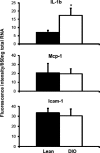Alteration of hepatic but not renal transporter expression in diet-induced obese mice
- PMID: 21430232
- PMCID: PMC3100907
- DOI: 10.1124/dmd.110.037507
Alteration of hepatic but not renal transporter expression in diet-induced obese mice
Abstract
Drug pharmacokinetics can be altered in obese and diabetic subjects. In consideration of the prevalence of obesity and diabetes, characterization of transporter expression in mouse models of diabetes and obesity may be a useful tool to aid in prediction of altered drug pharmacokinetics or adverse drug reactions. It has been reported that ob/ob mice, which display a severe obesity and diabetes phenotype, exhibit multiple changes in drug transporter expression in liver and kidney. In the present study, the mRNA and protein expression of major drug transporters was determined in livers and kidneys of diet-induced obese (DIO) C57BL/6J male mice. The mice were fed a high-fat diet (HFD) (60% fat) from 6 weeks of age and display obesity, fatty liver, and mild hyperglycemia. The HFD diet increased expression of multidrug resistance-associated proteins Abcc3 and 4 mRNA and protein in liver by 3.4- and 1.4-fold, respectively, compared with that detected in control mice fed a low-fat diet (LFD). In contrast, Abcc1 mRNA and protein decreased by 50% in livers of DIO mice compared with those in livers to lean mice. The HFD did not alter transporter expression in kidney compared with the LFD. In summary, unlike ob/ob and db/db mice, DIO mice exhibited a selective induction of efflux transporter expression in liver (i.e., Abcc3 and 4). In addition, diet-induced obesity affects transporter expression in liver but not kidney in the C57BL/6J mouse model. These data indicate that hepatic transporter expression is only slightly altered in a model of mild diabetes and nonalcoholic fatty liver disease and obesity.
Figures








Similar articles
-
Systematic Investigation of the Effects of Long-Term Administration of a High-Fat Diet on Drug Transporters in the Mouse Liver, Kidney and Intestine.Curr Drug Metab. 2019;20(9):742-755. doi: 10.2174/1389200220666190902125435. Curr Drug Metab. 2019. PMID: 31475894
-
Drug-metabolizing enzyme and transporter expression in a mouse model of diabetes and obesity.Mol Pharm. 2008 Jan-Feb;5(1):77-91. doi: 10.1021/mp700114j. Epub 2008 Jan 12. Mol Pharm. 2008. PMID: 18189363
-
Effect of caloric restriction and AMPK activation on hepatic nuclear receptor, biotransformation enzyme, and transporter expression in lean and obese mice.Pharm Res. 2013 Sep;30(9):2232-47. doi: 10.1007/s11095-013-1140-2. Epub 2013 Aug 16. Pharm Res. 2013. PMID: 23949303 Free PMC article.
-
Regulation of Hepatocellular Fatty Acid Uptake in Mouse Models of Fatty Liver Disease with and without Functional Leptin Signaling: Roles of NfKB and SREBP-1C and the Effects of Spexin.Semin Liver Dis. 2016 Sep;36(4):360-372. doi: 10.1055/s-0036-1597248. Epub 2016 Dec 20. Semin Liver Dis. 2016. PMID: 27997977
-
Modeling human nonalcoholic steatohepatitis-associated changes in drug transporter expression using experimental rodent models.Drug Metab Dispos. 2014 Apr;42(4):586-95. doi: 10.1124/dmd.113.055996. Epub 2014 Jan 2. Drug Metab Dispos. 2014. PMID: 24384915 Free PMC article.
Cited by
-
The altered renal and hepatic expression of solute carrier transporters (SLCs) in type 1 diabetic mice.PLoS One. 2015 Mar 19;10(3):e0120760. doi: 10.1371/journal.pone.0120760. eCollection 2015. PLoS One. 2015. PMID: 25789863 Free PMC article.
-
Perfluorooctanesulfonic acid (PFOS) administration shifts the hepatic proteome and augments dietary outcomes related to hepatic steatosis in mice.Toxicol Appl Pharmacol. 2020 Dec 1;408:115250. doi: 10.1016/j.taap.2020.115250. Epub 2020 Sep 23. Toxicol Appl Pharmacol. 2020. PMID: 32979393 Free PMC article.
-
Keap1 knockdown increases markers of metabolic syndrome after long-term high fat diet feeding.Free Radic Biol Med. 2013 Aug;61:85-94. doi: 10.1016/j.freeradbiomed.2013.03.007. Epub 2013 Mar 16. Free Radic Biol Med. 2013. PMID: 23507082 Free PMC article.
-
Effect of nonalcoholic steatohepatitis on renal filtration and secretion of adefovir.Biochem Pharmacol. 2016 Sep 1;115:144-51. doi: 10.1016/j.bcp.2016.07.001. Epub 2016 Jul 2. Biochem Pharmacol. 2016. PMID: 27381944 Free PMC article.
-
Lack of Multidrug Resistance-associated Protein 4 Prolongs Partial Hepatectomy-induced Hepatic Steatosis.Toxicol Sci. 2020 Jun 1;175(2):301-311. doi: 10.1093/toxsci/kfaa032. Toxicol Sci. 2020. PMID: 32142150 Free PMC article.
References
-
- Aleksunes LM, Slitt AM, Cherrington NJ, Thibodeau MS, Klaassen CD, Manautou JE. (2005) Differential expression of mouse hepatic transporter genes in response to acetaminophen and carbon tetrachloride. Toxicol Sci 83:44–52 - PubMed
-
- Bergman SJ, Speil C, Short M, Koirala J. (2007) Pharmacokinetic and pharmacodynamic aspects of antibiotic use in high-risk populations. Infect Dis Clin North Am 21:821–846, x - PubMed
-
- Buist SC, Klaassen CD. (2004) Rat and mouse differences in gender-predominant expression of organic anion transporter (Oat1–3; Slc22a6–8) mRNA levels. Drug Metab Dispos 32:620–625 - PubMed
-
- Bush EN, Shapiro R, Nuss M, Kaszubska W, Trevillyan J, Knourek-Segel V, Kennedy M, Adler A, Jirousek M, Jacobson P. (2001) Adiposity, leptin resistance, hyperrphagia, hyperglycemia, glucose intolerance and insulin resistance in C57BL/6J mice fed high fat diets, in Proceedings of the 83rd Annual Meeting and Expo of the Endocrine Society; 2001 Jun 20–23; Denver, CO The Endocrine Society, Chevy Chase, MD
Publication types
MeSH terms
Substances
Grants and funding
LinkOut - more resources
Full Text Sources
Medical
Molecular Biology Databases
Miscellaneous

